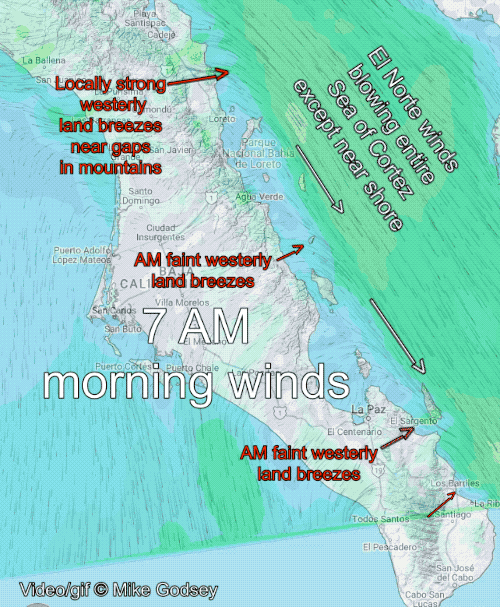If you've ever camped along the coast in the winter, you'll be well aware of the cool westerly winds that blow in most early mornings.
In this model animation from ikitesurf.com/WeatherFlow-Tempest, you can see the north wind that often blows throughout the night in the Sea of Cortez.
However, this 7am model animation clearly shows that although there are strong northerly winds outside, the winds nearshore are much weaker and more from the west.

Morning westerly winds in the Baja California Peninsula are driven by the difference in heat and cold between the land and ocean, a phenomenon common in most coastal areas.
Part 1 of this blog describes the general factors that contribute to early morning land breezes. Part 2 will detail the land breezes of Baja's eastern cape, specifically Rasta Beach, La Ventana, and the Los Barriles Launch Site.
Here's a breakdown of the main factors that contribute to land breezes:
1. Land cools down at night
If the sky is clear at night, the land surface cools faster than the ocean due to its lower ability to store heat. You've noticed that land heats up quickly during the day, while water heats up much more slowly. The same goes for heat dissipation.
So as the land cools, the air above it becomes denser and sinks, creating an area of higher pressure on the land than in the ocean.

2. Warm oceans retain heat
Because the waters of the Sea of Cortez retain more heat overnight, and the air above it remains relatively warm, resulting in lower pressure above the water.
3. pressure gradient
The difference in air pressure between cooler land (higher pressure) and warmer ocean (lower pressure) creates a pressure gradient.
4. Breeze
Air flows from high-pressure areas over land to low-pressure areas over oceans to equalize the pressure difference. This creates a westerly land breeze.

5. Baja California Geography
The elongated shape of the peninsula amplifies this effect. These breezes are enhanced by a stark temperature contrast between the cold Pacific Ocean to the west and the warm Sea of Cortez to the east.
6. Transition to daytime sea breeze
When the sun rises and the land warms, the process reverses. The land becomes warmer than the ocean and local pressure gradients increase in coastal valleys, causing a shift to easterly winds later in the day. However, if there is a northerly wind blowing from the Sea of Cortez, the same pressure gradient will cause the northerly wind to bend toward the coast, combining with the easterly wind. local sea breeze.
These land breezes are most noticeable on calm, clear nights when other weather patterns, such as strong winds or storms, are not dominant.
